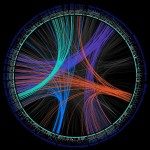Lien vers Pubmed [PMID] – 30326963
Clin Epigenetics 2018 Oct;10(1):123
BACKGROUND: The capacity of technologies measuring DNA methylation (DNAm) is rapidly evolving, as are the options for applicable bioinformatics methods. The most commonly used DNAm microarray, the Illumina Infinium HumanMethylation450 (450K array), has recently been replaced by the Illumina Infinium HumanMethylationEPIC (EPIC array), nearly doubling the number of targeted CpG sites. Given that a subset of 450K CpG sites is absent on the EPIC array and that several tools for both data normalization and analyses were developed on the 450K array, it is important to assess their utility when applied to EPIC array data. One of the most commonly used 450K tools is the pan-tissue epigenetic clock, a multivariate predictor of biological age based on DNAm at 353 CpG sites. Of these CpGs, 19 are missing from the EPIC array, thus raising the question of whether EPIC data can be used to accurately estimate DNAm age. We also investigated a 71-CpG epigenetic age predictor, referred to as the Hannum method, which lacks 6 probes on the EPIC array. To evaluate these epigenetic clocks in EPIC data properly, a prior assessment of the effects of data preprocessing methods on DNAm age is also required.
METHODS: DNAm was quantified, on both the 450K and EPIC platforms, from human primary monocytes derived from 172 individuals. We calculated DNAm age from raw, and three different preprocessed data forms to assess the effects of different processing methods on the DNAm age estimate. Using an additional cohort, we also investigated DNAm age of peripheral blood mononuclear cells, bronchoalveolar lavage, and bronchial brushing samples using the EPIC array.
RESULTS: Using monocyte-derived data from subjects on both the 450K and EPIC, we found that DNAm age was highly correlated across both raw and preprocessing methods (r > 0.91). Thus, the correlation between chronological age and the DNAm age estimate is largely unaffected by platform differences and normalization methods. However, we found that the choice of normalization method and measurement platform can lead to a systematic offset in the age estimate which in turn leads to an increase in the median error. Comparing the 450K and EPIC DNAm age estimates, we observed that the median absolute difference was 1.44-3.10 years across preprocessing methods.
CONCLUSIONS: Here, we have provided evidence that the epigenetic clock is resistant to the lack of 19 CpG sites missing from the EPIC array as well as highlighted the importance of considering the technical variance of the epigenetic when interpreting group differences below the reported error. Furthermore, our study highlights the utility of epigenetic age acceleration measure, the residuals from a linear regression of DNAm age on chronological age, as the resulting values are robust with respect to normalization methods and measurement platforms.

